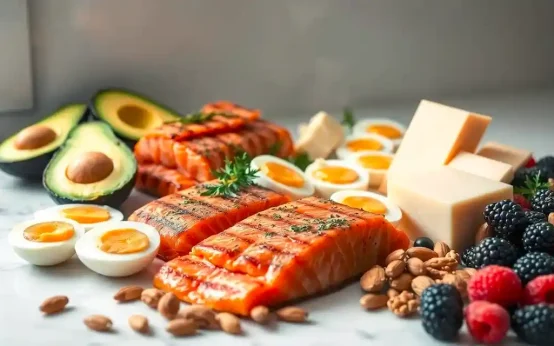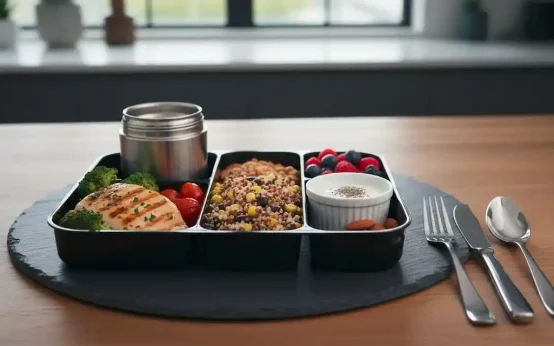Cold mornings, late sunsets, and heavy layers can mess with training. Your appetite dips, your routine shifts, and your recovery can suffer if you are not ready. The fix is not fancy. It is a short list of food rules you can apply today. With eating during winter to maintain muscle mass, aim for warm meals, smart calories, steady protein, and timing that supports your workouts.
You will learn what your body needs in cold weather, how to build a daily plate, when to eat around training, and which supplements help. You will also see common mistakes to avoid. By the end, you will have a clear plan you can repeat for the next three months, without stress or guesswork.
How eating during winter to maintain muscle mass works in your body
Cold weather changes your energy needs
Your body burns a bit more energy to stay warm. Training outdoors with layers adds more burn from movement and weight of clothing. On the flip side, short days can lower daily steps and gym time. That means your needs can swing. Watch your trend. If the scale or your strength drops for two weeks, add a small calorie cushion, about 150 to 250 calories per day. A bowl of oats with milk, an extra potato, or a yogurt does the job.
Protein drives repair and muscle protein synthesis
Protein is your anchor. Set a simple target: 0.7 to 1.0 grams per pound of body weight per day. Split it into 3 to 5 meals. Aim for 25 to 40 grams per meal. Pick leucine rich foods for a stronger muscle signal. Good options are dairy, eggs, poultry, fish, tofu, and soy. Keep it steady day after day, even on rest days.
Carbs power training and protect muscle
Carbs fuel hard work and help spare protein for repair. On training days, shoot for 1.0 to 1.5 grams per pound. On easy or rest days, go lower if your activity is light. Simple staples work well: oats, potatoes, rice, fruit, beans, and whole grain bread. Enjoy them around your workouts to keep your sessions strong.
Fats support hormones and joints in winter
Dietary fat keeps hormones stable and helps with joint comfort. Set a range of 0.3 to 0.4 grams per pound. Add olive oil, avocado, nuts, seeds, and fatty fish. These foods also help absorb vitamins A, D, E, and K. You do not need to chase high fat. Just include a little with each meal.
Hydration still matters in the cold
Dry air pulls moisture from your breath and skin. Heavy layers increase sweat loss, even if you do not notice it. Aim for 0.5 to 0.7 ounces of fluid per pound of body weight per day. Warm tea, broth, and water with a pinch of salt work well on active days. Sip across the day, not all at once.
Build your winter plate for steady strength and muscle
Daily protein, with easy sources that taste good warm
Pick proteins that feel cozy on cold days. You will stick to them longer.
- Greek yogurt, cottage cheese, eggs, tofu, tempeh, chicken thighs, turkey, lean beef, salmon, tuna, legumes, whey or casein.
- Quick servings: 3 eggs (~18 g), 6 oz Greek yogurt (~17 g), 4 oz cooked chicken (~30 g), 1 cup cooked lentils (~18 g).
- Add protein to soups, stews, chili, and oats. Stir in beans, shredded chicken, or a scoop of protein powder to hit your number without fuss.
Smart carbs that fuel winter workouts
Carbs should be simple to cook, easy on the budget, and tasty warm.
- Budget friendly carbs: oats, potatoes, sweet potatoes, rice, pasta, whole grain bread, beans, bananas, frozen fruit.
- Easy servings: 1 cup cooked oats, 1 medium potato, 1 cup cooked rice, 2 slices bread, 1 cup pasta.
- Pair carbs with protein. Oats with whey, rice with salmon, beans with turkey. This steadies blood sugar and keeps energy smooth.
Micronutrients that matter in winter
Short days and indoor time can leave gaps. Cover these key nutrients:
- Vitamin D: fatty fish, fortified milk or yogurt.
- Omega 3s: salmon, sardines, walnuts, flax.
- Magnesium: beans, nuts, greens.
- Zinc: beef, pumpkin seeds.
- Iron: red meat, beans, spinach with vitamin C. These help mood, recovery, and immune health. Food first, then fill gaps if needed.
Simple plate method for cold days
Use one plate to guide you without tracking.
- Half plate veggies and fruit.
- One quarter plate protein.
- One quarter plate carbs.
- Add 1 to 2 spoonfuls of healthy fat. On hard training days, grow the carb quarter. On rest days, pile on more veggies for volume and fiber.
Budget and seasonal picks that stretch protein
Save money and still eat for muscle.
- Protein staples: eggs, canned tuna and salmon, beans, lentils, peanut butter, chicken thighs, ground turkey.
- Produce: frozen mixed veggies, carrots, cabbage, kale, squash, potatoes.
- Carbs: oats, rice, pasta, whole grain bread. Buy frozen fruit for smoothies and pre chopped veggies to save time on busy weeks.
Timing your winter meals to recover faster and stay full
Pre workout fuel in cold weather
Eat 30 to 90 minutes before training. Combine 25 to 40 grams protein with 30 to 60 grams carbs.
- Oats with whey and a banana.
- Turkey sandwich on whole grain bread.
- Greek yogurt with granola and honey. Sip water or warm tea. Add a pinch of salt if you sweat a lot. You will feel warmer and start stronger.
Post workout recovery that fits busy days
Within 1 to 2 hours, aim for 30 to 45 grams protein and 40 to 80 grams carbs.
- Rice and salmon bowl with veggies.
- Chili with beans and beef.
- Tofu stir fry with rice and mixed veggies.
- Chocolate milk plus a turkey wrap. Add fruit for extra carbs and vitamins. This window keeps soreness in check and refills glycogen for your next session.
High protein comfort foods that match your macros
Make comfort work for your goals. Each dish below can deliver 25 to 40 grams protein per serving.
- Turkey bean chili.
- Chicken and veggie stew with potatoes.
- Lentil bolognese with pasta.
- Protein oats with peanut butter and milk. Batch cook on Sundays. Freeze single servings so weeknights stay simple.
Snacks that travel well in winter
Keep a few portable snacks ready in your bag or car.
- Beef or turkey sticks.
- Roasted chickpeas.
- Trail mix with nuts and a few dried fruit.
- Cottage cheese cups.
- Protein shakes.
- Cheese and whole grain crackers.
- Apples or clementines. If your meals are small, aim for 15 to 25 grams protein per snack to close the gap.
Sample 1 day winter meal plan for maintenance
Near 100 to 130 grams of protein for a 150 to 180 pound person. Scale up or down to match your needs.
- Breakfast: Protein oats with milk, whey, banana, and peanut butter (35 g protein).
- Lunch: Turkey bean chili with a side of rice (35 g).
- Snack: Greek yogurt with frozen berries and honey (20 g).
- Dinner: Salmon with potatoes and roasted carrots (35 g).
- Optional: Cottage cheese before bed if still hungry (15 g). This covers protein, carbs, healthy fats, and plenty of produce.
Supplements that help, mistakes to avoid, and who needs extra care
Supplements that actually support muscle in winter
A few well tested picks can help fill gaps.
- Creatine monohydrate: 3 to 5 g daily, any time.
- Whey or casein: 20 to 40 g to hit daily protein.
- Vitamin D3: 1000 to 2000 IU daily in low sun months, test if possible.
- Fish oil: 1 to 2 g EPA+DHA per day if you do not eat fish. Hydration still matters. Use electrolytes on long outdoor sessions or if you wear heavy layers.
Common winter eating mistakes that cost muscle
Avoid these traps:
- Under eating protein.
- Skipping meals due to busy holidays.
- Drinking more alcohol and missing sleep.
- Relying on sugary treats for energy.
- Low fiber intake that hurts fullness and digestion. Quick fixes:
- Set a daily protein floor.
- Plan 2 to 3 batch cooked meals.
- Cap drinks, space alcohol from training days.
- Keep fruit and nuts handy where you work.
Tips for vegetarians, vegans, and older lifters
- Vegetarian or vegan: lean on soy foods, seitan, legumes, and plant protein powders. Add B12 and consider algae based omega 3s.
- Older adults: aim for 30 to 40 grams protein per meal, include dairy or soy for leucine, and keep vitamin D checked. Add light creatine if your doctor agrees. Strength stays with practice and protein.
What to do when training is lighter or indoors
If your workouts drop, keep protein the same. Lower carbs slightly on rest days and keep steps high with short walks. Use at home strength work 2 to 3 days per week. Hit push, pull, squat, hinge, and carry patterns. A few sets with effort keeps the muscle signal strong until you ramp back up.
Wrap up: Warm meals, steady protein, and winter proof habits
Cold weather can tilt your habits, but your plan can be simple. Keep a steady protein target, match carbs to training, include healthy fats, and sip warm fluids. Time meals around workouts to lift strong and recover well. With eating during winter to maintain muscle mass, small consistent choices matter more than tricks. Pick one action this week, like batch cooking chili or setting a daily protein floor, and get started. Your spring strength depends on what you do now.
Related post:
How Your Diet Can Help With Aging Skin
Eating During Winter to Maintain Muscle Mass: FAQ
Do I need more calories in winter to maintain muscle?
Not always. If you spend most time indoors, your calorie needs are close to normal. If you’re more active outside or shiver often, you might need a small bump. To keep muscle, stay at maintenance or run a small surplus, about 200 to 300 calories per day, while training.
How much protein should I eat each day?
Aim for 1.6 to 2.2 grams per kilogram of body weight daily. Split it into 3 to 5 meals. Most people do well with 20 to 40 grams of protein per meal.
What’s the best way to time protein in cold months?
Eat protein every 3 to 5 hours. Hit at least 0.3 grams per kilogram per meal. A pre-sleep protein, like 30 to 40 grams of casein or Greek yogurt, supports overnight muscle repair.
Which protein sources help most?
Choose foods rich in leucine to trigger muscle building. Good picks include whey, dairy, eggs, poultry, lean beef, fish, soy, and seitan. Aim for 2 to 3 grams of leucine per meal, which you’ll get from about 25 to 35 grams of high-quality protein.
How many carbs do I need to train well in winter?
Carbs fuel hard sessions and help recovery. Most lifters need 3 to 5 grams per kilogram per day. Place more carbs before and after training for strength and energy.
What about fats?
Keep fats at 20 to 35 percent of total calories. Include omega-3s from fatty fish, algae oil, or fish oil. EPA and DHA support muscle retention and joint health.
Should I change my meal timing on rest days?
Keep protein steady, and match carbs to activity. Eat more carbs on training days, slightly fewer on rest days, while keeping calories near your target.
Do soups and stews help with winter nutrition?
Yes, if you build them right. Load them with lean meat, fish, tofu, or legumes. Add potatoes or whole grains, and plenty of vegetables. Finish with olive oil, avocado, nuts, or seeds for healthy fats.
How can I stay hydrated when I don’t feel thirsty?
Cold blunts thirst. Sip fluids through the day. A simple guide is 30 to 40 milliliters per kilogram of body weight daily, more if you train in layers and sweat. Pale yellow urine shows you’re on track. Add electrolytes if workouts are long.
Are there key vitamins or supplements for winter?
- Vitamin D3 supports muscle, bone, and immune health. Many people need 1,000 to 2,000 IU daily in winter, but the best dose comes from a blood test.
- Creatine monohydrate, 3 to 5 grams daily, boosts strength and helps muscle retention.
- Omega-3s, 1 to 2 grams of EPA+DHA daily if you don’t eat fish.
- Whey or casein protein powder for convenience.
How do holidays and big meals fit into my plan?
Anchor your day with protein at each meal, eat vegetables first, and choose one or two treats you really want. The next meal, return to your normal plan. One feast won’t erase your progress.
Can alcohol hurt muscle maintenance?
Yes. Alcohol blunts muscle protein synthesis, worsens sleep, and adds empty calories. If you drink, limit it, and pair drinks with protein-rich food. Skip training while buzzed.
What should I eat if I catch a cold?
Keep protein high, around your usual target. Stay hydrated. Eat easy carbs, like rice, oats, fruits, and soups, to meet energy needs. Resume hard training once fever and fatigue clear.
Any tips for plant-based eaters?
Build each meal around a complete or combined protein source. Use tofu, tempeh, soy milk, edamame, seitan, lentils with grains, or a quality vegan protein powder. Watch B12, iron, zinc, iodine, and omega-3s from algae oil.
What’s a simple winter day of eating to keep muscle?
- Breakfast: Greek yogurt, oats, berries, and nuts
- Lunch: Bean and beef chili, whole grain bread
- Snack: Whey shake and a banana
- Dinner: Salmon, potatoes, and roasted root veggies
- Pre-sleep: Cottage cheese with cinnamon
Do cold temperatures boost calorie burn enough to matter?
Not much for most people. Unless you spend long periods in real cold and shiver, the extra burn is small. Training and diet drive results.
How do I hit protein when appetite drops in winter?
Use warm, dense options. Chili, lentil soup with turkey, egg scrambles with cheese, tuna melts, oatmeal with whey, or hot cocoa made with milk and protein powder. Liquid calories can help on low-appetite days.
Is fiber important if I’m eating more?
Yes. Fiber helps digestion, fullness, and gut health. Aim for 25 to 40 grams per day from fruits, vegetables, legumes, oats, and whole grains. Increase water as fiber goes up.
What’s the best post-workout meal in winter?
A full meal with 0.3 grams per kilogram of protein and a good carb source works well. Examples: chicken and rice, chili with potatoes, or eggs on toast with fruit. Add some salt if you sweat a lot.
How often should I adjust calories as winter goes on?
Review body weight and strength weekly. If weight drops and strength stalls, add 150 to 250 calories per day. If fat gain climbs and strength doesn’t, pull back by 150 to 250 calories. Keep protein steady.




 The Best Food for the Keto Diet
The Best Food for the Keto Diet  Can You Lose Weight on Carnivore Diet?
Can You Lose Weight on Carnivore Diet?  High Protein Meal Prep Ideas for the Week
High Protein Meal Prep Ideas for the Week  Tryptophan Snacks for Intermittent Fasting
Tryptophan Snacks for Intermittent Fasting  How to Eat In Portion Control
How to Eat In Portion Control  How Your Diet Can Help With Aging Skin
How Your Diet Can Help With Aging Skin